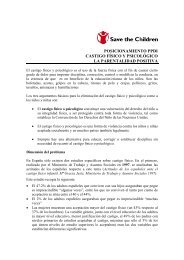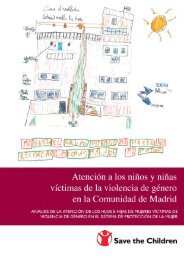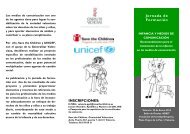Nutrition in the First 1,000 Days - Save the Children
Nutrition in the First 1,000 Days - Save the Children
Nutrition in the First 1,000 Days - Save the Children
Create successful ePaper yourself
Turn your PDF publications into a flip-book with our unique Google optimized e-Paper software.
24 SaviNg liveS aND BUilDiNg a Better FUtUre: loW-coSt SolUtioNS that WorK<br />
Promot<strong>in</strong>g and support<strong>in</strong>g<br />
early <strong>in</strong>itiation of<br />
Breastfeed<strong>in</strong>g<br />
Despite its benefits, many women delay<br />
<strong>in</strong>itiation of breastfeed<strong>in</strong>g. Only 43 percent<br />
of newborns <strong>in</strong> develop<strong>in</strong>g countries are<br />
put to <strong>the</strong> breast with<strong>in</strong> one hour of birth.<br />
Establish<strong>in</strong>g good breastfeed<strong>in</strong>g practices<br />
<strong>in</strong> <strong>the</strong> first days is critical to <strong>the</strong> health of<br />
<strong>the</strong> <strong>in</strong>fant and to breastfeed<strong>in</strong>g success.<br />
Initiat<strong>in</strong>g breastfeed<strong>in</strong>g is easiest and most<br />
successful when a mo<strong>the</strong>r is physically<br />
and psychologically prepared for birth and<br />
breastfeed<strong>in</strong>g and when she is <strong>in</strong>formed,<br />
supported, and confident of her ability to<br />
care for her newborn. The follow<strong>in</strong>g actions<br />
can <strong>in</strong>crease rates of early <strong>in</strong>itiation of<br />
breastfeed<strong>in</strong>g:<br />
• Identify <strong>the</strong> practices, beliefs, concerns<br />
and constra<strong>in</strong>ts to early and exclusive<br />
breastfeed<strong>in</strong>g and address <strong>the</strong>m through<br />
appropriate messages and changes <strong>in</strong><br />
delivery and postnatal procedures<br />
• Counsel women dur<strong>in</strong>g prenatal care on<br />
early <strong>in</strong>itiation and exclusive breastfeed<strong>in</strong>g<br />
• Upgrade <strong>the</strong> skills of birth attendants to<br />
support early and exclusive breastfeed<strong>in</strong>g<br />
• Make sk<strong>in</strong>-to-sk<strong>in</strong> contact and <strong>in</strong>itiation<br />
of breastfeed<strong>in</strong>g <strong>the</strong> first rout<strong>in</strong>e after<br />
delivery<br />
• Praise <strong>the</strong> mo<strong>the</strong>r for giv<strong>in</strong>g colostrum<br />
(<strong>the</strong> “first milk”), provide ongo<strong>in</strong>g<br />
encouragement, and assist with position-<br />
<strong>in</strong>g and attachment<br />
Breastfeed<strong>in</strong>g – Human breast milk provides all <strong>the</strong> nutrients newborns<br />
need for healthy development and also provides important antibodies aga<strong>in</strong>st<br />
common childhood illnesses. Exclusive breastfeed<strong>in</strong>g prevents babies from<br />
<strong>in</strong>gest<strong>in</strong>g contam<strong>in</strong>ated water that could be mixed with <strong>in</strong>fant formula. The<br />
protective benefits of breastfeed<strong>in</strong>g have been shown to be most significant with<br />
6 months of exclusive breastfeed<strong>in</strong>g and with cont<strong>in</strong>uation after 6 months, <strong>in</strong><br />
comb<strong>in</strong>ation with nutritious complementary foods (solids), up to age 2. In<br />
conditions that normally exist <strong>in</strong> develop<strong>in</strong>g countries, breastfed children are<br />
at least 6 times more likely to survive <strong>in</strong> <strong>the</strong> early months than non-breastfed<br />
children.65<br />
Complementary feed<strong>in</strong>g – When breast milk alone is no longer sufficient<br />
to meet a child’s nutritional needs, o<strong>the</strong>r foods and liquids must be added<br />
to a child’s diet <strong>in</strong> addition to breast milk. Optimal complementary feed<strong>in</strong>g<br />
<strong>in</strong>volves factors such as <strong>the</strong> quantity and quality of food, frequency and<br />
timel<strong>in</strong>ess of feed<strong>in</strong>g, food hygiene, and feed<strong>in</strong>g dur<strong>in</strong>g/after illnesses. The<br />
target range for complementary feed<strong>in</strong>g is 6-23 months.66 WHO notes that<br />
breastfeed<strong>in</strong>g should not be decreased when start<strong>in</strong>g complementary feed<strong>in</strong>g;<br />
complementary foods should be given with a spoon or a cup, not <strong>in</strong> a bottle;<br />
foods should be clean, safe and locally available; and ample time should be given<br />
for young children to learn to eat solid foods.67 Rates of malnutrition among<br />
children usually peak dur<strong>in</strong>g <strong>the</strong> time of complementary feed<strong>in</strong>g. Growth<br />
falter<strong>in</strong>g is most evident between 6-12 months, when foods of low nutrient<br />
density beg<strong>in</strong> to replace breast milk and rates of diarrheal illness due to food<br />
contam<strong>in</strong>ation are at <strong>the</strong>ir highest.68 Dur<strong>in</strong>g <strong>the</strong> past decade, <strong>the</strong>re has been<br />
considerable improvement <strong>in</strong> breastfeed<strong>in</strong>g practices <strong>in</strong> many countries; however,<br />
similar progress has not been made <strong>in</strong> <strong>the</strong> area of complementary feed<strong>in</strong>g.<br />
Complementary feed<strong>in</strong>g is a proven <strong>in</strong>tervention that can significantly reduce<br />
stunt<strong>in</strong>g dur<strong>in</strong>g <strong>the</strong> first two years of life.69 If all children <strong>in</strong> <strong>the</strong> develop<strong>in</strong>g<br />
world received adequate complementary feed<strong>in</strong>g, stunt<strong>in</strong>g rates at 12 months<br />
could be cut by 20 percent.70<br />
Vitam<strong>in</strong> A supplements – Roughly a third of all preschool-age children<br />
(190 million)71 and 15 percent of pregnant women (19 million)72 do not have<br />
enough vitam<strong>in</strong> A <strong>in</strong> <strong>the</strong>ir daily diet. Vitam<strong>in</strong> A deficiency is a contribut<strong>in</strong>g<br />
factor <strong>in</strong> <strong>the</strong> 1.3 million deaths each year from diarrhea among children and <strong>the</strong><br />
nearly 118,<strong>000</strong> deaths from measles.73 Severe deficiency can also cause irreversible<br />
corneal damage, lead<strong>in</strong>g to partial or total bl<strong>in</strong>dness. Vitam<strong>in</strong> A capsules<br />
given to children twice a year can prevent bl<strong>in</strong>dness and lower a child’s risk of<br />
death from common childhood diseases – at a cost of only 2 cents per capsule.74<br />
It is estimated that at least 2 percent of child deaths could be prevented if all<br />
children under age 5 received two doses of vitam<strong>in</strong> A each year.75<br />
Z<strong>in</strong>c for diarrhea – Diarrhea causes <strong>the</strong> death of 1.3 million children76 each<br />
year, most of <strong>the</strong>m between <strong>the</strong> ages of 6 months and 2 years.77 Young children<br />
are especially vulnerable because a smaller amount of fluid loss causes significant<br />
dehydration, because <strong>the</strong>y have fewer <strong>in</strong>ternal resources, and because<br />
<strong>the</strong>ir energy requirements are higher. <strong>Children</strong> <strong>in</strong> develop<strong>in</strong>g nations suffer an<br />
average of three cases of diarrhea a year.78 Diarrhea robs a child’s body of vital<br />
nutrients, caus<strong>in</strong>g malnutrition. Malnutrition, <strong>in</strong> turn, decreases <strong>the</strong> ability<br />
of <strong>the</strong> immune system to fight fur<strong>the</strong>r <strong>in</strong>fections, mak<strong>in</strong>g diarrheal episodes<br />
more frequent. Repeated bouts of diarrhea stunt children’s growth and keep<br />
<strong>the</strong>m out of school, which fur<strong>the</strong>r limits <strong>the</strong>ir chances for a successful future.

















